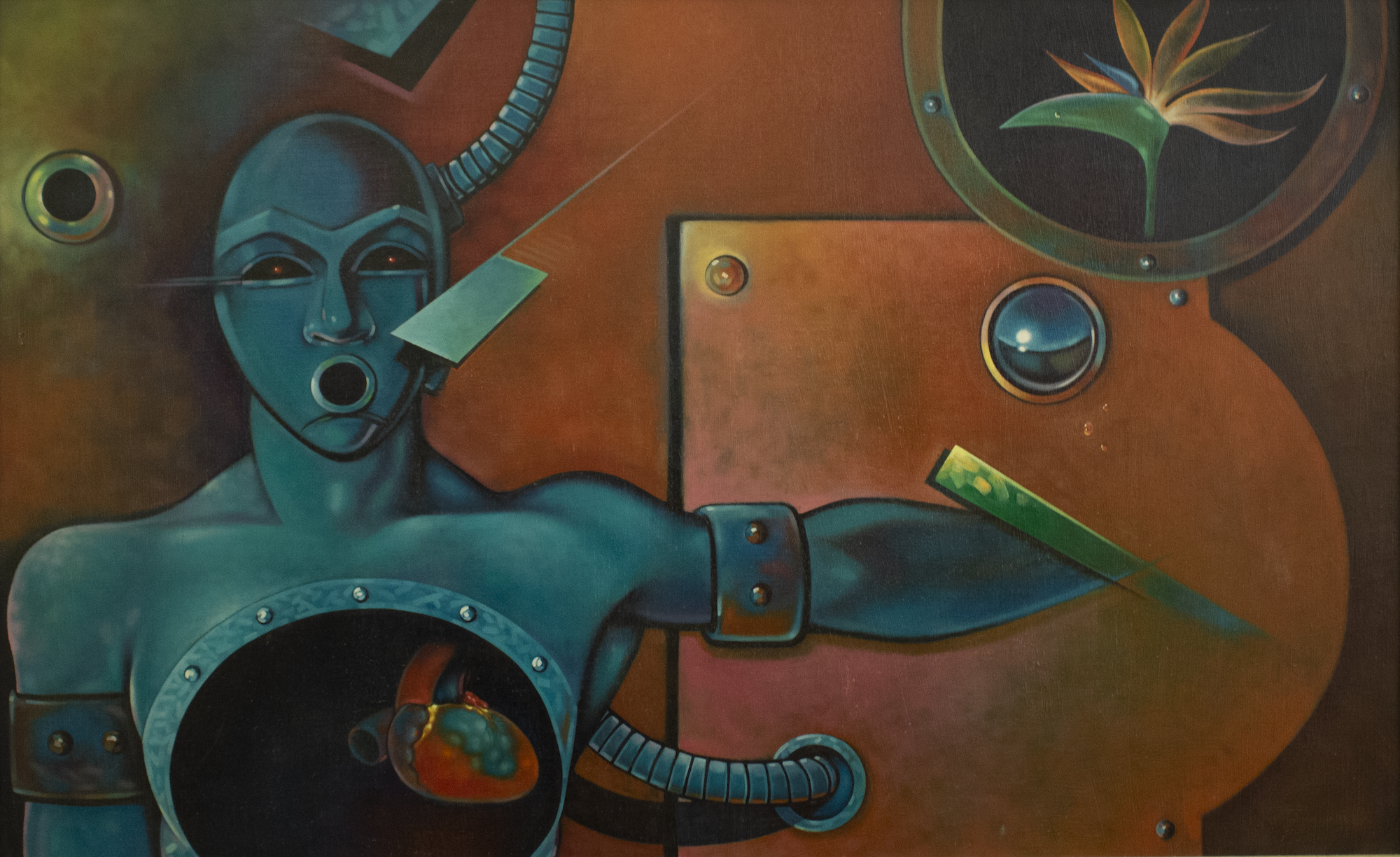
By Natalie Willis
Jolyon Smith’s Transformation (1987) is one of the first works collected for the National Collection at the NAGB, shown in the Inaugural National Exhibition or the INE. To have a work that appears so afrofuturist in its aesthetic speaks volumes for the genre and also for the nascent years of the NAGB in thinking what a National Collection could and should look like. What does a Black future look like, and a Bahamian one at that?
Afrofuturism, though the term was coined in 1993 by cultural critic Mark Dery (in an aptly titled paper, “Black to the Future”), is a genre of work investigating the idea of Black futures. Utilising sci-fi culture and the rapidly expanding technological advances since the early 1900s, Afrofuturism considers the aesthetic and scientific futures of the Black diaspora – a mix of history and projected futures. Considering that so much technological advancement is rooted in the excess of wealth being allocated to this research – perhaps the very same wealth accumulated from many of our ancestors during the era of slavery and colonialism – it is quite fitting then to consider how these technologies and philosophies on science and history affect Black futures. The electrocardiogram or ECG (1900), the first plane flight (1903), radio broadcasting (1906), sonar (1916), and countless other significant progressions in tech (tied so often to war) came in part out of the most difficult moments of Black history.
“Transformation” (1987), Jolyon Smith, oil on canvas, 30 x 48 inches. Part of the National Collection.
The abolition of slavery, our emancipation, (and the subsequent period of “apprenticeship” to extract yet more free labour) came directly in the run up to the race for technological advancement, birthed out of colonialism and empire and the industrial epoch that hinged upon it. For Jolyon Smith, a Jamaican-Bahamian (or Bahamian of Jamaican heritage, as identity is a tricky and deeply personal thing) who had grown up in the aftermath of the West Indies Federation, a toddler of independence, “Transformation” (1987) speaks not only of the environment he grew up in but the strides toward Independence and national pride for post-colonies, but also towards the 1970’s Black pride that was taking firm rooting in the West and those adjacent.
A blue robotic man-droid is hooked up via tubing to his background, leaving him perhaps immobilised, with an open chasm in his chest revealing an exposed heart. To the right of the man, a porthole in the metal bolted walls reveals a Bird of Paradise flower. A common device in science fiction is to use other skin colours and races to talk about our own issues with race as human beings, and Smith’s blue half-man, half-robot seems to be in alignment with this. He is between states – not quite allowed to be a man, restrained – and the addition of the Bird of Paradise is a tongue-in-cheek nod to Caribbeanness, the not-quite-paradise we call home.
The work feels hopeful amidst its potential for dystopian narratives – a world of half-men chained to walls, but this single bloom growing, and the man’s exposed heart, show that perhaps all is not lost, that humanity is not lost. It is not lost on me that such a work comes in the wake of the Chernobyl disaster, of the horrific Challenger rocket explosion. Questions on human advancement and its cost on human life are centred, giving us a moment to consider this not just through our Blackness in Afrofuturism, but also more specifically through our Caribbeanness being brought back to the forefront.
In thinking now on climate change, our talk of ‘killing the planet’ and other such arrogance – because, truly, the planet will be fine, it is ourselves we are slowly killing off by way of unfettered capitalist progressions. We have steamrollered our way to a digital future that cannot sustain us, scythed down plantations of cotton, sugar, coffee, through force and we seem to now be paying the cost of it. Smith, very much in tune with the goings on of the world as well as his spirituality, almost takes on the role of prophet in this. What kind of Bahamas will we have if we are underwater? Will we, in 20 or 30 years time, only be able to see the land we call home through the porthole of a submarine? Questions worth considering, and questions well asked as this work continues to build meaning through (treacherous, and difficult) time.
This work and others in your Bahamian National Collection will be on view as part of the new rehanging of the Permanent Exhibition. “Timelines: 1950-2007” is curated by NAGB Assistant Curator Richardo Barrett and takes a look at our art history through its lineages – a chance to reflect on where we’ve come from, and where we are going. “Timelines: 1950-2007” will be on view through mid 2020.
